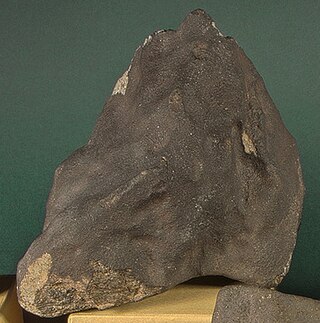Top Qs
Timeline
Chat
Perspective
Tamdakht meteorite
Meteorite that fell in Morocco in 2008 From Wikipedia, the free encyclopedia
Remove ads
The Tamdakht meteorite fell near Ouarzazate, Morocco on 20 December 2008 producing a strewn field of approximately 25 kilometres (16 mi) by 2 kilometres (1.2 mi) and two small impact craters, one of about 1.1 metres (3 ft 7 in) diameter and 70 centimetres (28 in) depth at 31°09.8′N 7°00.9′W and the other of about 20 centimetres (7.9 in) diameter and 10 centimetres (3.9 in) depth at 31°09.9′N 07°02.3′W.[1]
This article needs additional citations for verification. (March 2022) |
The meteorite is named after a village close to the fall.[2]
On April 22, 2017, small bits of the meteorite were handed out to children at the Boston March for Science.
Remove ads
Mineralogy
Petrology: (by Albert Jambon, Omar Boudouma, D. Badia UPVI and M. Denise, MNHNP[1]): Abundant chondrules with visible but not well-delimited outlines. Chondrule size is 0.1 to 1.5 mm. Dominant olivine and orthopyroxene. Abundant chromite, rare clinopyroxene and ilmenite. Numerous pockets with chromite, plagioclase and phosphate (merrilite and Cl-apatite). Kamacite, with deformed Neumann bands, and taenite, twinned troilite. Copper. Mode: metal+troilite 10%.
Mineral compositions and geochemistry:[1] log χ = 5.3. Olivine Fa18 ± 0.5 Opx = En83 Fs16 Wo2 Minor calcic pyroxene. Plagioclase is Ab83–86 An5–15 Or7–2. Ca-phosphate (merrillite and Cl-apatite). Chromite: Cr# (100× molar Cr/[Cr + Al]) = 82. Metal: kamacite with 5% Ni and taenite with 36–47% Ni. Oxygen isotopes (C. Suavet, J. Gattacecca CEREGE): δ17O = 3.26‰, δ18O = 5.01‰, and Δ17O = 0.65‰. Magnetic susceptibility is log χ = 5.3 × 10–9 m3/kg.
Remove ads
Classification
Ordinary chondrite (H5), S3, W0.[1]
Other
- In 2016, the Cook Islands issued a collector coin in which a piece of the meteorite is embedded.[3]
See also
References
Wikiwand - on
Seamless Wikipedia browsing. On steroids.
Remove ads

